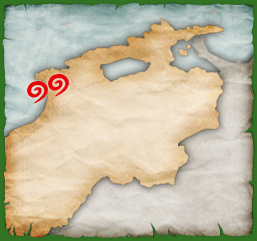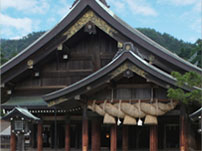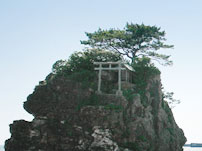Sengu
- What is Sengu?
- Architectural Details
- Process
- Ise Connection
What is Sengu?
Written by Dustin Kidd
Any time work is done on a shrine building, from simple roof repairs to a complete rebuilding of the shrine, or even a relocation of the shrine building, the residing deity is moved to a temporary shrine; this is referred to as a sengu. The temporary shrine building is often referred to as a kari-honden, but at Izumo Taisha it is called Okariden. Then, once all work is finished, the deity is returned to the repaired, rebuilt, or relocated shrine. This is because a shrine is considered to be a holy place, and things like people standing on a shrine roof to work or noisy construction are considered offensive to the gods. Sengu are done for physical shrine upkeep, but there is a spiritual aspect as well; by making the shrine new again, a sengu symbolizes a renewal of power and vitality for the deity of that shrine. The most well-known example of a sengu is that of the Grand Shrine of Ise in Mie Prefecture, where all the shrine buildings on the grounds are completely rebuilt every 20 years.
While most shrines only have a sengu when work is absolutely necessary, Izumo Taisha is one of the other few examples of a sengu being held on a regular schedule. Izumo Taisha’s sengu, as a general rule, is held every 60 years. At 24 meters tall, Izumo Taisha’s main hall is the tallest of its kind in Japan, and a complete reconstruction at its current size is infeasible. There are no longer any trees left in Japan of the height and width necessary to build a 24-meter high shrine building, so in order preserve the current main hall as long as possible, each time a sengu is conducted, Izumo Taisha’s main hall is reroofed, and any other necessary repairs on the building structure are performed. Sengu have been performed on the main hall three times previously, in 1809, 1881, and 1953.
Izumo Taisha’s current sengu started in 2008 and is scheduled to finish in 2013, the same year of completion as the next sengu for the Grand Shrine of Ise.
- Dustin Kidd, Japanese Cultural Scholar
- Author of “Oi Genki Ka!?”, a collection of essays about life in Japan and “San-in English School”, a daily column about different facets of life in the San-in Region of Japan, which ran from Oct. 2009 to Mar 2011.
Lecturer: “Comparing Japanese and Greek Mythology”, “Experiences with Shinto”, “The Appeal of Shinto and Buddhism.”
Visiting Locations connected to Izumo Taisha
Izumo Taisha is located on the western end of the Shimane Peninsula, in the Taisha area of Izumo City. A large shrine gate, said to be the largest in Japan, towers over the main road to Izumo Taisha and welcomes visitors to the area. Izumo Taisha is easily accessible by car, bus, or train, and the area around the shrine bustles with tourists and visitors to the shrine, especially on the weekends.
If you follow the road that passes in front of the shrine grounds, you will soon arrive at Inasa-no-Hama beach. This beach is part of Sono-no-nagahama, a place that plays a large role in the Kunibiki legend, and is where Takemikazuchi presented Okuninushi with his demands to turn over Ashihara-no-nakatsukuni to Amaterasu, and where Takeminakata challenged him to a test of strength. It is also where, every year at the Kami-mukae-sai, all of the gods from around Japan are welcomed to Izumo Taisha, and the procession back to Izumo Taisha from the beach follows a path through town along the Kami Mukae Road.


Izumo Taisha
195 Kizukihigashi, Taisha-cho, Izumo City, Shimane

Inasa-no-Hama
Kizukikita, Taisha-cho, Izumo City, Shimane













